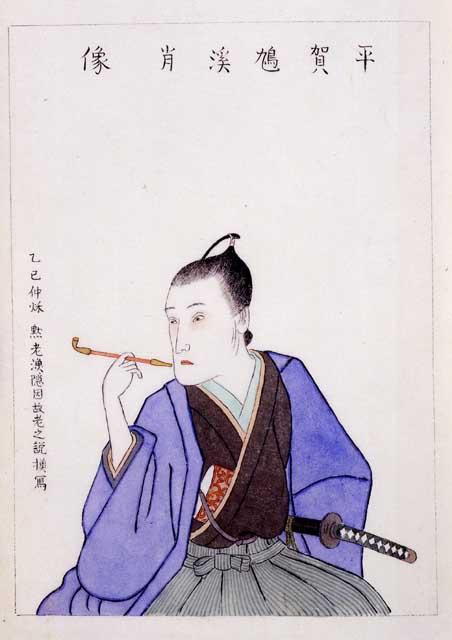
Portrait of Gennai Hiraga (Mokuro Kimura, Gesakusha kouhoi, Meiji period)
Portrait of Gennai Hiraga (Mokuro Kimura, Gesakusha kouhoi, Meiji period)

Gennai Hiraga (1728-1779) was a naturalist and gesakusha or author of popular stories in the mid-Edo period who was active in Edo after having travelled to Nagasaki to study. Adopting Western technology, he made, among other things, thermometers and elekiters (electrostatic generators) in addition to contributing to industrial developments by devising asbestos cloth, Gennai Ware pottery, etc. As a gesakusha, his work Shinrei Yaguchi no watashi (The Yaguchi ferry and the magic arrows) and humorous essays Furyu Shidoken den (The tale of dashing Shidoken) and Hohiron (On farting) are famed, and he is also said to be a pioneer of Western-style painting. Although he mistakenly killed another person in his later years and died while in prison, he is sometimes referred to as the "Da Vinci of Japan" because of his multiple talents and the diversity of his activities. This portrait was drawn by an elder of the Takamatsu domain, Kimura Mokuro (who died at the age of 85 in 1856), in 1845 after Gennai had passed away based on a conversation with an elderly person who had known Gennai well. It is said that Mokuro's grandfather had been on friendly terms with Gennai. A wallet made from Japanese leather paper (kinkarakawa) that was also developed by Gennai can be seen poking out from the breast pocket of his kimono. This portrait was drawn in Gesakusha kouhoi (Supplementary observations on authors of popular stories) that expands on Bakin Kyokutei's Kinsei mono no hon Edo sakusha burui (Edo authors: the categories of the modern novel) and Hokaishi Ishizuka's Gesakusha senshu (Selected authors of popular stories), adding portraits of the gesakusha. Because the original portrait has already been lost, this book, with an extant copy, is invaluable. [204@152@2]

